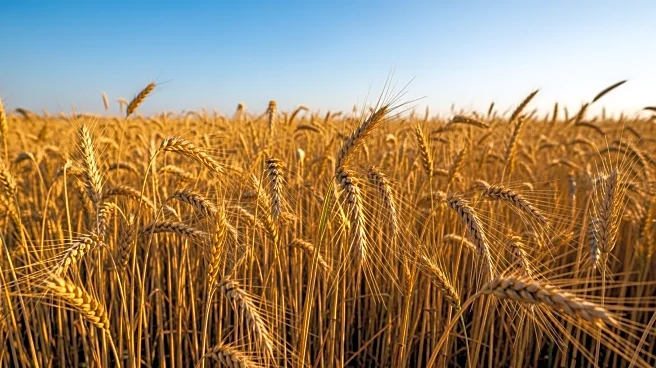What's Happening?
Wheat futures in the United States have experienced a decline in overnight trading, influenced by strong global production and favorable weather conditions in the southern Plains. The U.S. Department of
Agriculture projected global wheat output at 816.2 million metric tons for the 2025/2026 marketing year, an increase from the previous season's 800.9 million tons. Russian wheat production is also expected to rise, with consultancy SovEcon forecasting 87.8 million metric tons, up from an earlier estimate of 87.2 million tons. In the U.S., about 66% of the winter crop has been planted, according to a Reuters poll, although official data is unavailable due to a government shutdown. Intermittent rain is predicted in the southern Plains, favoring areas such as west-central Kansas, western Oklahoma, and northwestern Texas. Wheat futures for December delivery fell to $4.96 a bushel on the Chicago Board of Trade, while Kansas City futures dropped to $4.85 3/4 a bushel.
Why It's Important?
The decline in wheat futures reflects broader trends in global agriculture, where increased production in major exporting countries like Russia can impact U.S. market prices. Favorable weather conditions in the southern Plains are crucial for winter crop planting, potentially leading to a robust harvest. However, the ongoing government shutdown has disrupted the availability of official crop progress reports, creating uncertainty for farmers and traders. The fluctuation in futures prices can affect U.S. farmers' revenue and influence decisions on crop management and investment. Additionally, the interplay between global production levels and local weather conditions underscores the complexity of agricultural markets and the need for adaptive strategies in response to changing environmental and economic factors.
What's Next?
As the government shutdown continues, stakeholders in the agricultural sector may face challenges in accessing timely and accurate data, which could affect market predictions and decision-making. Farmers in the southern Plains will need to monitor weather forecasts closely to optimize planting schedules and manage crop health. The international wheat market will likely remain competitive, with U.S. producers needing to strategize around global production trends. The potential for further rain in key planting areas could support crop growth, but farmers must remain vigilant against possible adverse weather events. The resolution of the government shutdown will be critical in restoring access to essential agricultural data and reports.
Beyond the Headlines
The current situation highlights the vulnerability of agricultural markets to political disruptions, such as government shutdowns, which can impede access to vital information. The reliance on global production data emphasizes the interconnectedness of international trade and the need for U.S. farmers to remain competitive in a globalized market. The environmental aspect, with favorable weather aiding planting, also points to the importance of sustainable agricultural practices and climate resilience. Long-term strategies may involve investing in technology and infrastructure to better predict and respond to weather patterns, ensuring the stability and profitability of U.S. agriculture.














